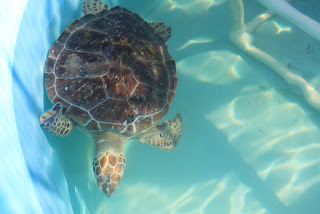A short way down U.S. 1 (known as Useless 1 to the natives) from where we're staying, is the world's only State-approved Sea Turtle Hospital. Gavyn would love this place! And it's closer than the Galapagos Islands.
A $15 admission fee buys you a 30 minute Power-Point presentation on the five different kinds of sea turtles found around Florida and the work of the hospital to save wounded and sick turtles. That's followed by a one-hour visit to the salt-water holding pools where the recovering turtles are being treated and where the ones who can no longer fend for themselves have taken up residence in the salt-water swimming pool of a former motel. The motel rooms are still used by the staff (who have their own swimming pool) and are right on the Gulf side of Marathon Key. Dock-space is also available for any staff who have their own boat.
The guest turtles range in size from a cute 6-incher to a four-foot Loggerhead who masses some 300 pounds. The biggest turtles, the Leatherbacks are Pelagic and seldom seen near shore. They can weigh up to 2000 pounds and live for 45 years. Injuries range from speargun wounds to collision damage from boats, near amputations by fishing line, impaction from eating plastic garbage, shark bites and tumour-like growths. Some never recover completely and become permanent residents.
The facility boasts an operating room complete with x-ray machine, anaesthetic machine and a complete array of machines to do blood analysis. It is a non-profit organization, subsisting on grants (the turtles are protected species), donations and the entrance fees.
When one finds a turtle in distress, one is to call the Florida Wildlife Commission or the Turtle Hospital. Clearly, if you find a turtle that needs help, while out paddling a kayak, you can't just heave it aboard and row to shore. Sometimes the FWC get involved, sometimes even the Coast Guard. When the turtle has been brought to shore, the Turtle Hospital's ambulance whisks it away for specialized care. The hospital trains vets who remain on call to come and help as needed. This is a crucial part of the operation since Veterinary Colleges don't have time to teach students about every animal found in the wild.
An interesting and informative visit. If you're in the area, do drop in. You can find out more at: http://www.turtlehospital.org/
Oh, and if you do rescue a turtle that gets taken to the hospital, you get to name it.
Calm sea this morning
The hospital sign
Turtle ambulances
Operating room
X-Ray of a turtle with a spear-gun spear in his head. The hospital removed it and he survived.
Isolation tanks for recovering turtles.
Hello.
Jersey, in recovery from operation to remove papilloma growths.
Little guy. Future turtle ambassador to schools.
Loggerhead resident. He can no longer control his dives properly and so will stay.
Pretty Green Sea Turtle, recovering from an operation on left rear flipper.











No comments:
Post a Comment